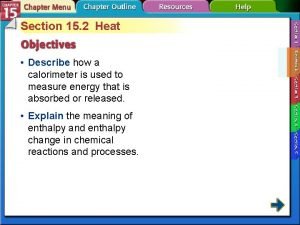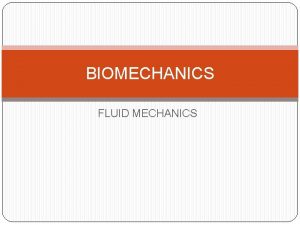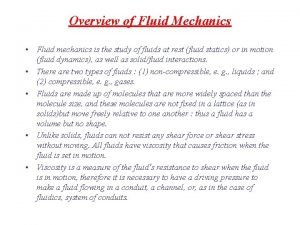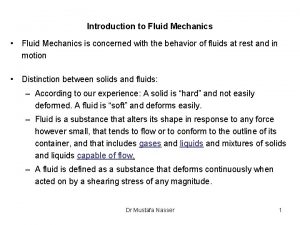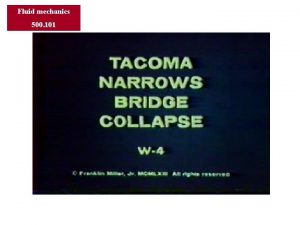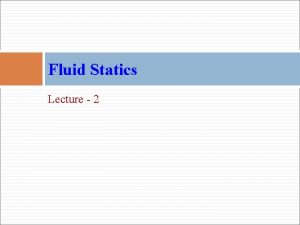FLUID MECHANICS studying fluid mechanics WHY on a


























- Slides: 26

FLUID MECHANICS

? studying fluid mechanics WHY on a Civil Engineering course ?

q Services such as the supply of potable water, drainage, sewerage are essential for the development of industrial society. It is these services which civil engineers provide. q Fluid mechanics is involved in nearly all areas of Civil Engineering either directly or indirectly. Some exmples of direct involvement are those where we are concerned with manipulating the fluid: Sea and River (Flood) defenses; Water distribution / sewerage (sanitation) networks; Hydraulic design of water/ seawage treatment works; Weir & Dams; Irrigation & Drainage; Pumps & Turbines; etc….

q And some examples where the primary object is construction - yet analysis of the fluid mechanics is Essential: � Flow of air in / around buildings; � Bridge piers in rivers; � Ground-water flow. q Notice how nearly all of these involve water. The following course, although introducing general fluid flow ideas and principles, will demonstrate many of these principles through examples where the fluid is water.

FLUID MECHANICS AND FLUID PROPERTIES Objectives of this section � Define the nature of a fluid. � Show where fluid mechanics concepts are common with those of solid mechanics and indicate some fundamental areas of difference. � Introduce viscosity and show what are Newtonian and non. Newtonian fluids � Define the appropriate physical properties and show these allow differentiation between solids and fluids as well as between liquids and gases.

Fluid There are two aspects of fluid mechanics which make it different to solid mechanics: 1. The nature of a fluid is much different to that of a solid 2. In fluids we usually deal with continuous streams of fluid without a beginning or end. In solids we only consider individual elements. We normally recognize three states of matter: solid; liquid and gas. However, liquid and gas are both fluids: in contrast to solids they lack the ability to resist deformation. Because a fluid cannot resist the deformation force, it moves, it flows under the action of the force. Its shape will change continuously as long as the force is applied. A solid can resist a deformation force while at rest, this force may cause some displacement but the solid does not continue to move indefinitely.

� The deformation is caused by shearing forces which act tangentially to a surface. Referring to the figure below, we see the force F acting tangentially on a rectangular (solid lined) element ABDC. This is a shearing force and produces the (dashed lined) rhombus element A’B’DC.

Shearing force, F, acting on a fluid element.

So We can say : A fluid is a substance which deforms continuously, or flows, when subjected to shearing forces. and conversely this definition implies the very important point that: If a fluid is at rest there are no shearing forces acting. All forces must be perpendicular to the planes which the are acting.

When a fluid is in motion shear stresses are developed if the particles of the fluid move relative to one another. When this happens adjacent particles have different velocities. If fluid velocity is the same at every point then there is no shear stress produced: the particles have zero relative velocity. Consider the flow in a pipe in which water is flowing. At the pipe wall the velocity of the water will be zero. The velocity will increase as we move toward the centre of the pipe. This change in velocity across the direction of flow is known as velocity profile and shown graphically in the figure below: Velocity profile in a pipe.

Because particles of fluid next to each other are moving with different velocities there are shear forces in the moving fluid i. e. shear forces are normally present in a moving fluid. On the other hand, if a fluid is along way from the boundary and all the particles are travelling with the same velocity, the velocity profile would look something like this: v Velocity profile in uniform flow and there will be no shear forces present as all particles have zero relative velocity. In practice we are concerned with flow past solid boundaries; aero planes, cars, pipe walls, river channels etc. and shear forces will be present.

Newton’s Law of Viscosity How can we make use of these observations? We can start by considering a 3 d rectangular element of fluid, like that in the figure below Fluid element under a shear force

The shearing force F acts on the area on the top of the element. This area is given by A = ds ´dx. We can thus calculate the shear stress which is equal to force per unit area i. e. shear stress, The deformation which this shear stress causes is measured by the size of the angle f and is know as shear strain. In a solid shear strain, f, is constant for a fixed shear stress t. In a fluid f increases for as long as t is applied - the fluid flows.

If the particle at point E (in the above figure) moves under the shear stress to point E’ and it takes time t to get there, it has moved the distance x. For small deformations we can write Shear Strain, Rate of Shear Strain, where is the velocity of the particle at E. Using the experimental result that shear stress is proportional to rate of shear strain then

The term is the change in velocity with y, or the velocity gradient, and may be written in the differential form The constant of proportionality is known as the dynamic iscosity, µ , of the fluid, giving This is known as Newton’s law of viscosity

Fluid Vs Solid � � For a solid the strain is a function of the applied stress (providing that the elastic limit has not been reached). For a fluid, the rate of strain is proportional to the applied stress. The strain in a solid is independent of the time over which the force is applied and (if the elastic limit is not reached) the deformation disappears when the force is removed. A fluid continues to flow for as long as the force is applied and will not recover its original form when the force is removed.

Newtonian / Non-Newtonian Fluids � � Fluids in which the value of m is not constant are known as non-Newtonian fluids. There are several categories of these, and they are outlined briefly below. These categories are based on the relationship between shear stress and the velocity gradient (rate of shear strain) in the fluid. These relationships can be seen in the graph below for several categories

Each of these lines can be represented by the equation where A, B and n are constants. For Newtonian fluids A = 0, B = m and n = 1.

Liquids vs. Gasses � � A liquid is difficult to compress and often regarded as being incompressible. A gas is easily to compress and usually treated as such - it changes volume with pressure. A given mass of liquid occupies a given volume and will occupy the container it is in and form a free surface (if the container is of a larger volume). A gas has no fixed volume, it changes volume to expand to fill the containing vessel. It will completely fill the vessel so no free surface is formed.

Viscosity in Gasses � � The molecules of gasses are only weakly kept in position by molecular cohesion (as they are so far apart). As adjacent layers move by each othere is a continuous exchange of molecules. Molecules of a slower layer move to faster layers causing a drag, while molecules moving the other way exert an acceleration force. Mathematical considerations of this momentum exchange can lead to Newton law of viscosity. If temperature of a gas increases the momentum exchange between layers will increase thus increasingviscosity. Viscosity will also change with pressure - but under normal conditions this change is negligible in gasses.

Viscosity in Liquids � � Cohesion plays an important roll in the viscosity of liquids. Increasing the temperature of a fluid reduces the cohesive forces and increases the molecular interchange. Reducing cohesive forces reduces shear stress, while increasing molecular interchange increases shear stress. High pressure can also change the viscosity of a liquid. As pressure increases the relative movement of molecules requires more energy hence viscosity increases.

Properties of Fluids Density The density of a substance is the quantity of matter contained in a unit volume of the substance. It can be expressed in three different ways. Mass Density, ρ (kg / m³) , is defined as the mass of substance per unit volume Specific Weight (N / m³), (known as specific gravity) is defined as the weight per unit volume. Or The force exerted by gravity, g, upon a unit volume of the substance per unit volume.

Properties of Fluids � Relative Density, σ , is defined as the ratio of mass density of a substance to some standard mass density. For solids and liquids this standard mass density is the maximum mass density for water at atmospheric pressure. � Typical values: Water = 1, Mercury = 13. 5, Paraffin Oil =0. 8.

Viscosity � � Viscosity, , is the property of a fluid, due to cohesion and interaction between molecules, which offers resistance to sheer deformation. Different fluids deform at different rates under the same shear stress. Fluid with a high viscosity such as syrup, deforms more slowly than fluid with a low viscosity such as water.

Coefficient of Dynamic Viscosity � � The Coefficient of Dynamic Viscosity, , is defined as the shear force, per unit area, (or shear stress ), required to drag one layer of fluid with unit velocity past another layer a unit distance away. Units :

Kinematic Viscosity � Kinematic Viscosity, v , is defined as the ratio of dynamic viscosity to mass density. � Units :
 Boundary layer theory
Boundary layer theory Hey bye bye
Hey bye bye Why are chemists interested in studying thermochemistry?
Why are chemists interested in studying thermochemistry? Dont ask
Dont ask Synovial membrane
Synovial membrane P1-p2
P1-p2 Fluid statics deals with fluid at rest
Fluid statics deals with fluid at rest Transcellular fluid compartment
Transcellular fluid compartment Ecf icf and interstitial fluid
Ecf icf and interstitial fluid Hypoosmotic
Hypoosmotic Movement of body fluids
Movement of body fluids Saag ascites formula
Saag ascites formula Stokes fluid mechanics
Stokes fluid mechanics Fluid mechanics subject code
Fluid mechanics subject code Total head formula
Total head formula Dimensionless groups in fluid mechanics
Dimensionless groups in fluid mechanics Hazen and williams formula
Hazen and williams formula Fluid mechanics pdhpe
Fluid mechanics pdhpe Dimensionless numbers in fluid mechanics
Dimensionless numbers in fluid mechanics Mece
Mece Fluid mechanics energy equation
Fluid mechanics energy equation Specific energy in fluid mechanics
Specific energy in fluid mechanics Fundamentals of fluid mechanics
Fundamentals of fluid mechanics Hydrostatic force equation
Hydrostatic force equation Holt physics chapter 8 fluid mechanics test answers
Holt physics chapter 8 fluid mechanics test answers Similitude fluid mechanics
Similitude fluid mechanics Momentum equations
Momentum equations


